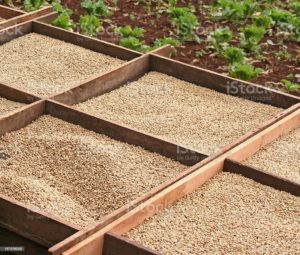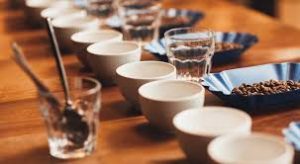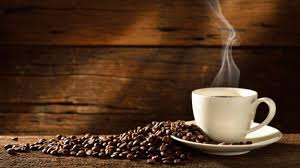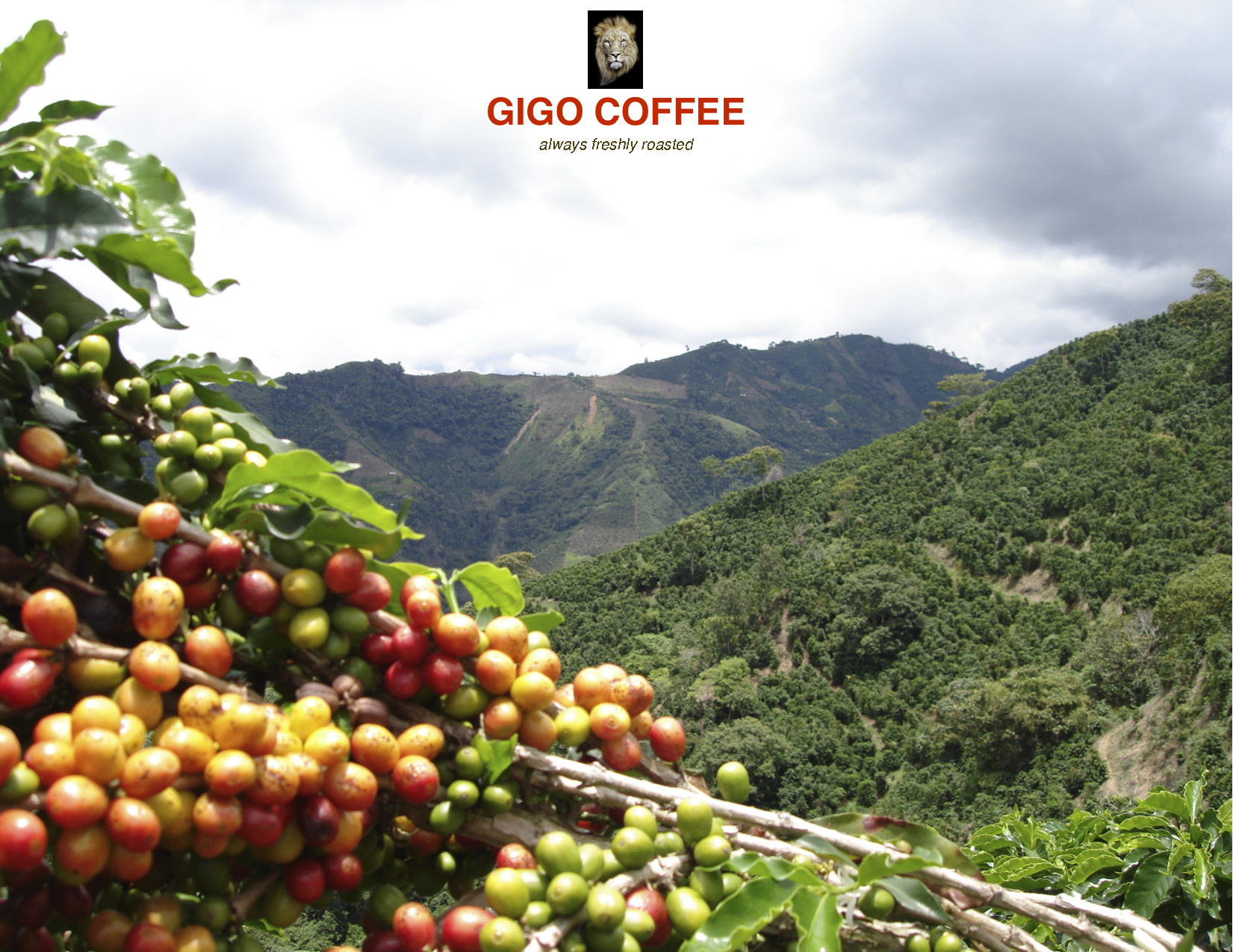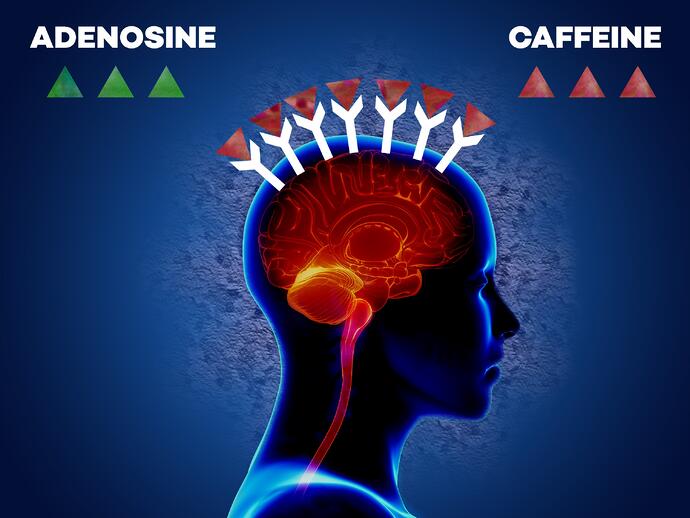
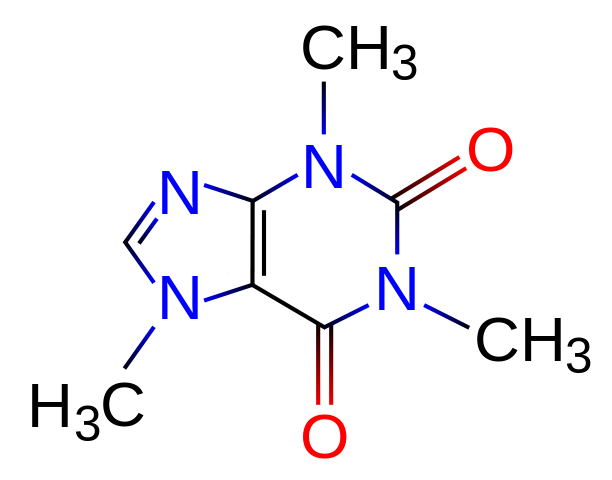


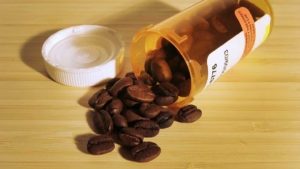
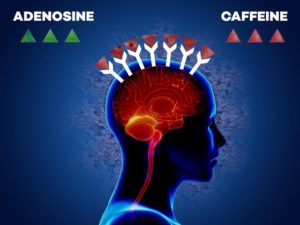
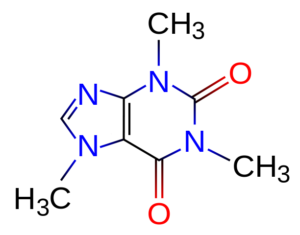

Coffee contains a number of useful nutrients, including: Riboflavin (vitamin B2),
Niacin (vitamin B3),
Magnesium,
Potassium,
Various phenolic compounds,
Antioxidants.
HEALTH BENEFITS OF COFFEE:
Coffee boosts your physical performance. …
Coffee may help you lose weight. …
Coffee helps you burn fat. …
Coffee helps you focus and stay alert. …
Coffee lowers risk of death. …
Coffee reduces risk of cancers. …
Coffee reduces risk of stroke. …
Coffee reduces risk of Parkinson’s disease.
Coffee may help you lose weight.
Coffee contains magnesium and potassium, which helps the human body use insulin, regulating blood sugar levels and reducing your craving for sugary treats and snacks.
Moderate caffeine intake, 1-6 cups a day, helps you focus and improves your mental alertness.
 Coffee lowers risk of death.
Studies have shown that coffee drinker’s overall risk of premature death is 25% lower than of those who don’t drink coffee.
Coffee reduces risk of cancers.
One study has shown that coffee may decrease the risk of developing prostate cancer in men by 20 %, and endometrial cancer in women by 25 %. People in the test group drank four cups of coffee a day. Caffeine may also prevent developing of basal cell carcinoma, the most common type of skin cancer
Coffee reduces risk of stroke.
Reasonable consumption of coffee (2–4 cups a day) is associated with lower risk of stroke.
Coffee reduces risk of Parkinson’s disease.
Studies have shown that regular coffee drinking decreases risk of Parkinson’s disease by 25 %. There’s evidence that coffee causes activity in the part of the brain affected by Parkinson’s.
Coffee lowers risk of death.
Studies have shown that coffee drinker’s overall risk of premature death is 25% lower than of those who don’t drink coffee.
Coffee reduces risk of cancers.
One study has shown that coffee may decrease the risk of developing prostate cancer in men by 20 %, and endometrial cancer in women by 25 %. People in the test group drank four cups of coffee a day. Caffeine may also prevent developing of basal cell carcinoma, the most common type of skin cancer
Coffee reduces risk of stroke.
Reasonable consumption of coffee (2–4 cups a day) is associated with lower risk of stroke.
Coffee reduces risk of Parkinson’s disease.
Studies have shown that regular coffee drinking decreases risk of Parkinson’s disease by 25 %. There’s evidence that coffee causes activity in the part of the brain affected by Parkinson’s.
 Coffee lowers risk of death.
Studies have shown that coffee drinker’s overall risk of premature death is 25% lower than of those who don’t drink coffee.
Coffee reduces risk of cancers.
One study has shown that coffee may decrease the risk of developing prostate cancer in men by 20 %, and endometrial cancer in women by 25 %. People in the test group drank four cups of coffee a day. Caffeine may also prevent developing of basal cell carcinoma, the most common type of skin cancer
Coffee reduces risk of stroke.
Reasonable consumption of coffee (2–4 cups a day) is associated with lower risk of stroke.
Coffee reduces risk of Parkinson’s disease.
Studies have shown that regular coffee drinking decreases risk of Parkinson’s disease by 25 %. There’s evidence that coffee causes activity in the part of the brain affected by Parkinson’s.
Coffee lowers risk of death.
Studies have shown that coffee drinker’s overall risk of premature death is 25% lower than of those who don’t drink coffee.
Coffee reduces risk of cancers.
One study has shown that coffee may decrease the risk of developing prostate cancer in men by 20 %, and endometrial cancer in women by 25 %. People in the test group drank four cups of coffee a day. Caffeine may also prevent developing of basal cell carcinoma, the most common type of skin cancer
Coffee reduces risk of stroke.
Reasonable consumption of coffee (2–4 cups a day) is associated with lower risk of stroke.
Coffee reduces risk of Parkinson’s disease.
Studies have shown that regular coffee drinking decreases risk of Parkinson’s disease by 25 %. There’s evidence that coffee causes activity in the part of the brain affected by Parkinson’s.
Coffee protects your body.Coffee contains a lot of antioxidants, that work as little warriors fighting and protecting against free radicals within your body.
Coffee may lower risk of Type II diabetes.
Caffeine decreases your insulin sensitivity and impairs glucose tolerance, therefore reduces your risk of type 2 diabetes.
 Coffee protects your brain.
High caffeine levels in your blood reduce the risk of Alzheimer disease. It also lowers risk of dementia.
Coffee brightens your mood, helps fight depression and lowers risk of suicide.
Caffeine stimulates the central nervous system and boosts production of neurotransmitters like serotonin, dopamine, and noradrenaline, which elevate your mood. Two cups of coffee a day prevents risk of suicide by 50 %.
Coffee protects your brain.
High caffeine levels in your blood reduce the risk of Alzheimer disease. It also lowers risk of dementia.
Coffee brightens your mood, helps fight depression and lowers risk of suicide.
Caffeine stimulates the central nervous system and boosts production of neurotransmitters like serotonin, dopamine, and noradrenaline, which elevate your mood. Two cups of coffee a day prevents risk of suicide by 50 %.
Two Types of Coffee beans: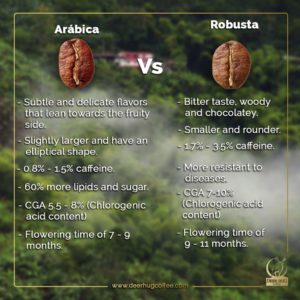
 Arabica is smoother and sweeter while Robusta is infamous for its bitter and traditional “coffee” flavor.
There are two main types of coffee species, Arabica and Robusta. Arabica originates from Ethiopia and produces a mild, flavorful tasting coffee. It is the most popular type worldwide. However, it is expensive to grow because the Arabica plant is sensitive to the environment, requiring shade, humidity, and steady temperatures between 60-75 degrees Fahrenheit. The Robusta coffee plant is more economical to grow because it is resistant to disease and survives in a wider range of temperatures between 65-97 degrees Fahrenheit. It can also withstand harsh climate changes such as variations in rainfall and strong sunlight.
Type of roast:
Coffee beans start out green. They are roasted at a high heat to produce a chemical change that releases the rich aroma and flavor that we associate with coffee. They are then cooled and ground for brewing. Roasting levels range from light to medium to dark. The lighter the roast, the lighter the color and roasted flavor and the higher its acidity. Dark roasts produce a black bean with little acidity and a bitter roasted flavor. The popular French roast is medium-dark.
Arabica is smoother and sweeter while Robusta is infamous for its bitter and traditional “coffee” flavor.
There are two main types of coffee species, Arabica and Robusta. Arabica originates from Ethiopia and produces a mild, flavorful tasting coffee. It is the most popular type worldwide. However, it is expensive to grow because the Arabica plant is sensitive to the environment, requiring shade, humidity, and steady temperatures between 60-75 degrees Fahrenheit. The Robusta coffee plant is more economical to grow because it is resistant to disease and survives in a wider range of temperatures between 65-97 degrees Fahrenheit. It can also withstand harsh climate changes such as variations in rainfall and strong sunlight.
Type of roast:
Coffee beans start out green. They are roasted at a high heat to produce a chemical change that releases the rich aroma and flavor that we associate with coffee. They are then cooled and ground for brewing. Roasting levels range from light to medium to dark. The lighter the roast, the lighter the color and roasted flavor and the higher its acidity. Dark roasts produce a black bean with little acidity and a bitter roasted flavor. The popular French roast is medium-dark.

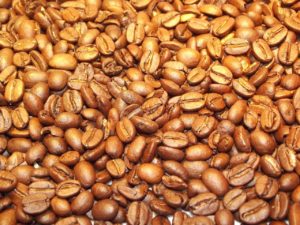

 Type of grind.
Type of grind.
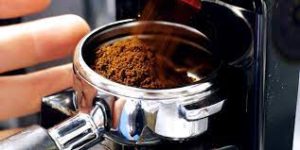 A medium grind is the most common and used for automatic drip coffee makers. A fine grind is used for deeper flavors like espresso, which releases the oils, and a coarse grind is used in coffee presses.
Decaffeinated coffee. This is an option for those who experience unpleasant side effects from caffeine. The two most common methods used to remove caffeine from coffee is to apply chemical solvents (methylene chloride or ethyl acetate) or carbon dioxide gas. Both are applied to steamed or soaked beans, which are then allowed to dry. The solvents bind to caffeine and both evaporate when the beans are rinsed and/or dried. According to U.S. regulations, at least 97% of the caffeine must be removed to carry the decaffeinated label, so there may be trace residual amounts of caffeine. Both methods may cause some loss of flavor as other naturally occurring chemicals in coffee beans that impart their unique flavor and scent may be destroyed during processing.
A medium grind is the most common and used for automatic drip coffee makers. A fine grind is used for deeper flavors like espresso, which releases the oils, and a coarse grind is used in coffee presses.
Decaffeinated coffee. This is an option for those who experience unpleasant side effects from caffeine. The two most common methods used to remove caffeine from coffee is to apply chemical solvents (methylene chloride or ethyl acetate) or carbon dioxide gas. Both are applied to steamed or soaked beans, which are then allowed to dry. The solvents bind to caffeine and both evaporate when the beans are rinsed and/or dried. According to U.S. regulations, at least 97% of the caffeine must be removed to carry the decaffeinated label, so there may be trace residual amounts of caffeine. Both methods may cause some loss of flavor as other naturally occurring chemicals in coffee beans that impart their unique flavor and scent may be destroyed during processing.
 Coffee protects your brain.
High caffeine levels in your blood reduce the risk of Alzheimer disease. It also lowers risk of dementia.
Coffee brightens your mood, helps fight depression and lowers risk of suicide.
Caffeine stimulates the central nervous system and boosts production of neurotransmitters like serotonin, dopamine, and noradrenaline, which elevate your mood. Two cups of coffee a day prevents risk of suicide by 50 %.
Coffee protects your brain.
High caffeine levels in your blood reduce the risk of Alzheimer disease. It also lowers risk of dementia.
Coffee brightens your mood, helps fight depression and lowers risk of suicide.
Caffeine stimulates the central nervous system and boosts production of neurotransmitters like serotonin, dopamine, and noradrenaline, which elevate your mood. Two cups of coffee a day prevents risk of suicide by 50 %.

 Arabica is smoother and sweeter while Robusta is infamous for its bitter and traditional “coffee” flavor.
There are two main types of coffee species, Arabica and Robusta. Arabica originates from Ethiopia and produces a mild, flavorful tasting coffee. It is the most popular type worldwide. However, it is expensive to grow because the Arabica plant is sensitive to the environment, requiring shade, humidity, and steady temperatures between 60-75 degrees Fahrenheit. The Robusta coffee plant is more economical to grow because it is resistant to disease and survives in a wider range of temperatures between 65-97 degrees Fahrenheit. It can also withstand harsh climate changes such as variations in rainfall and strong sunlight.
Type of roast:
Coffee beans start out green. They are roasted at a high heat to produce a chemical change that releases the rich aroma and flavor that we associate with coffee. They are then cooled and ground for brewing. Roasting levels range from light to medium to dark. The lighter the roast, the lighter the color and roasted flavor and the higher its acidity. Dark roasts produce a black bean with little acidity and a bitter roasted flavor. The popular French roast is medium-dark.
Arabica is smoother and sweeter while Robusta is infamous for its bitter and traditional “coffee” flavor.
There are two main types of coffee species, Arabica and Robusta. Arabica originates from Ethiopia and produces a mild, flavorful tasting coffee. It is the most popular type worldwide. However, it is expensive to grow because the Arabica plant is sensitive to the environment, requiring shade, humidity, and steady temperatures between 60-75 degrees Fahrenheit. The Robusta coffee plant is more economical to grow because it is resistant to disease and survives in a wider range of temperatures between 65-97 degrees Fahrenheit. It can also withstand harsh climate changes such as variations in rainfall and strong sunlight.
Type of roast:
Coffee beans start out green. They are roasted at a high heat to produce a chemical change that releases the rich aroma and flavor that we associate with coffee. They are then cooled and ground for brewing. Roasting levels range from light to medium to dark. The lighter the roast, the lighter the color and roasted flavor and the higher its acidity. Dark roasts produce a black bean with little acidity and a bitter roasted flavor. The popular French roast is medium-dark.



 Type of grind.
Type of grind.
 A medium grind is the most common and used for automatic drip coffee makers. A fine grind is used for deeper flavors like espresso, which releases the oils, and a coarse grind is used in coffee presses.
Decaffeinated coffee. This is an option for those who experience unpleasant side effects from caffeine. The two most common methods used to remove caffeine from coffee is to apply chemical solvents (methylene chloride or ethyl acetate) or carbon dioxide gas. Both are applied to steamed or soaked beans, which are then allowed to dry. The solvents bind to caffeine and both evaporate when the beans are rinsed and/or dried. According to U.S. regulations, at least 97% of the caffeine must be removed to carry the decaffeinated label, so there may be trace residual amounts of caffeine. Both methods may cause some loss of flavor as other naturally occurring chemicals in coffee beans that impart their unique flavor and scent may be destroyed during processing.
A medium grind is the most common and used for automatic drip coffee makers. A fine grind is used for deeper flavors like espresso, which releases the oils, and a coarse grind is used in coffee presses.
Decaffeinated coffee. This is an option for those who experience unpleasant side effects from caffeine. The two most common methods used to remove caffeine from coffee is to apply chemical solvents (methylene chloride or ethyl acetate) or carbon dioxide gas. Both are applied to steamed or soaked beans, which are then allowed to dry. The solvents bind to caffeine and both evaporate when the beans are rinsed and/or dried. According to U.S. regulations, at least 97% of the caffeine must be removed to carry the decaffeinated label, so there may be trace residual amounts of caffeine. Both methods may cause some loss of flavor as other naturally occurring chemicals in coffee beans that impart their unique flavor and scent may be destroyed during processing.




